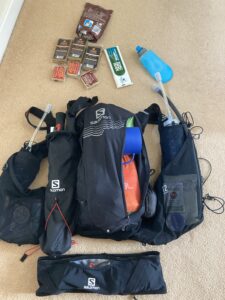
First a caveat: we are not nutritionists, so the following is based on our experience, common sense, and the ‘numbers’ are based on best practice. If you feel you need nutritional advice we recommend finding a sport specific nutritionist, or drop us a note and we can introduce you to one.
What we do know, and what you really really need to know if you are preparing for an ultra, is that getting nutrition wrong during an event is cited in up to 40% of ultramarathon DNFs (Did Not Finish). The key issues are under feeding, developing Gastro-Intestinal (GI) issues, dehydration, and (occasionally) over-hydrating. In this article we will cover some of the key things you can do to minimise the risks of your gut letting you down on race day.
Nutrition Needs
First some numbers. You need to be able to consume around 250 calories an hour whilst on the move, of which you should be aiming for around 90 grams of Carbohydrate (CHO) with a 2:1 glucose to fructose mix.
These are not absolute numbers, we are all different, but they are a great place to start (and note in most research athletes rarely achieve the 90g/hr of carbs, normally hitting nearer 60).
But nutrition planning and training must be a central part of your overall training plan if you are to be successful.
- First, your gut needs to be trained to work effectively whilst you are exercising. This takes time and like all training the more you do it the better it gets. You should be practicing your nutrition plan (more later) on every long run.
- Second, working out which foods work for you, and which don’t, can take a lot of trial and error. Doing this early will reduce the chances of stomach issues derailing your event.
- There are many who have become used to getting their nutrition during an event just from gels and other such supplements. This is possible up to a marathon distance – but trust us you won’t want to take this approach on anything over 50k; it is not a recipe for success on an ultramarathon
You must practice eating the food for your event in training. Different foods will have an adverse effect on you and your gut when you start adding exercise into the mix. Whilst a rapid visit to the bush isn’t necessarily an event ending scenario, chronic stomach ache, vomiting and diarrhea can be!
What about fat and protein you cry…yes you need both(!) At around Ultra pace you will be taking about 50% of energy from CHO and the other 50% from fat. Yep, you are an Ultra athlete, so you will be fat adjusted…no fancy diets required.
Nutrition Plan
So how do you develop your nutrition plan? Simply start at expected duration, add 15%, and multiply by 250 (or 90)! e.g. 50 miles, I’m expecting to complete in 8 hours, so I’ll plan for 10. That means I need at least 2500 calories, of which I’ll need 900g of CHO. And you need a mix of foods. Not only the numbers above but you should aim for a protein intake of 0.25g per kg of body weight per hr.
OK, that’s the easy bit. Now what foods will you use. As already stated, although gels are tempting they become sickly at some point for most people. We favour a mix of sweet and savoury, as well as ensuring we have some ‘real’ food thrown in the mix. This can include cold pizza (one of our favourites!), mini pies, sandwiches, fruit and nut trail mix, as well as specialist bars and gels. But note that bars and gels aren’t cheap and they aren’t essential as long as you hit your numbers!
If your event is a series of picnics with a run between (!) ensure you find out what food is available beforehand and train with it. But caution, we have seen many event where the ‘menu’ has changed on the day; I suffered my worst ever ‘bonk’ on a 150 mile cycle ride where this happened and the feed stops only had a brand of gel I knew made me sick…and I foolishly was reliant on them, not myself (lesson learned!).
Ideally, build in your own options. Your palate will change significantly over the duration of an Ultra and you need to have the ability to ‘switch it up’ and keep the nutrition going in.
You should be training with event food twice a week, try overloading your gut and getting even more calories in. And make note of what doesn’t work so you can adapt your plan.
As an example, here’s my (zero aid stations) menu for 50 miles, expected duration around 9 hours (calories in brackets):
- Savoury Bars x3 (900).
- Gel flask (300). With three gels decanted in. Used if I needed an instant boost if/when I got behind on nutrition plan.
- Trail mix (1000) – fruit and nut mix with chocolate M&Ms; grabbed a handful on most uphills where I slowed to a walk. This is my go to.
- Luchos Dillitos x3 (300) cut into 1/4s in with trail mix.
- KMC Kendal Mint Bar x1 (340)
- Mountain Fuel Chia gel (400) – spare if I needed a real kick.
- Mini Pork Pie x2 (200)
Hydration

How much water you need will depend on the weather, and how much you sweat. But you should be aiming for between 400 and 800 ml an hour.
Underhydrate and you will suffer. So, if you are thirsty, drink. If your pee is orange, drink. If you can’t pee, drink (quite a lot!).
We prefer to stay on top of our hydration by calculating desired consumption (see below) and sipping regularly (every 10 minutes for example).
However, overhydrate and you can be very ill (Hyponatremia) – Damian Hall’s infamous leans at the end of his record breaking UK coast-to-coast could have been much worse. He had overcompensated for the heat, ended up with hyponatremia and could have ended up in a lot of trouble.
Working out how much fluid you need.
The best way of knowing how much water you need to take on is to conduct multiple sweat tests in various temperatures, as follows:
If you’ve enjoyed and made use of our insights, consider buying us a coffee to say thanks:
Like what you see?
Try one of our holistic training plans to really increase your chances of success
Our plans are broken down into a 4 week blocks, with each block focused on a specific aspect of your training. Our team have built plans using their own experience, knowledge (and quite a collection of personal ‘lessons’ such as those above) to help you fully prepare and avoid some of the pitfalls, mistakes and pain we have suffered on our own Ultramarathon journeys. Each 4-week block includes details on preparing physically and mentally, as well as ensuring your equipment is ready and won’t let you down on the day.
When you purchase one of our plans, we will give you access to our members only Strava Club and Whatsapp group so you can talk to, be encouraged by, motivated and helped by other runners. It’s a club after all, and seeing other runners working towards their goals, sharing their highs and lows, and ultimately becoming your tribe and support network, will hugely increase your chance of success.
Our plans can be found here.
If you don’t see what you need in our standard plans, don’t hesitate to get in touch.
